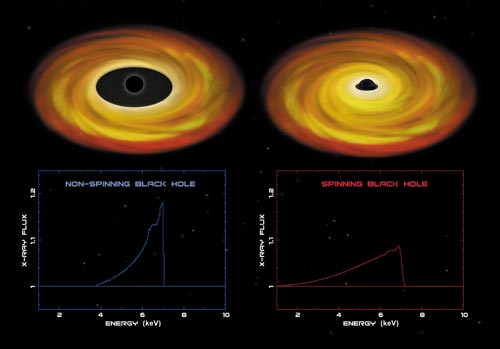
Do all black holes spin? How fast do they spin? The most detailed studies of stellar black holes to date by NASA’s Chandra X-ray Observatory and the European Space Agency’s XMM-Newton satellite have found observational evidence that some stellar black holes have high spin rates.
Stellar black holes have masses between five and 20 times that of the Sun. They are probably formed during supernova explosions, when the core of a massive star collapses once its nuclear fuel is exhausted. A gamma-ray burst might be the signature of such an event (CERN Courier September 2003 p15).
Black holes remain hidden in our galaxy unless they are close enough to another star to manifest their strong gravitational pull. In tight binary systems composed of a star and a black hole rotating around each other, the black hole strips the star of its outer layers. This material then forms a swirling disc of gas around the compact object. The gas rotates faster the closer it gets to the black hole and is heated, due to friction, to up to tens of millions of degrees. At such temperatures the gas is ionized and emits X-rays.
Iron atoms in the swirling gas around a black hole produce distinctive emission lines. These spectral features can be used to study the orbits of particles around the black hole. For example, the gravity of a black hole can shift the emitted X-rays to lower energies. The orbit of a particle near a black hole depends on the curvature of space induced by the black hole, which also depends on how fast the black hole is spinning. A spinning black hole drags space around with it and allows atoms to orbit closer to the black hole than is possible for a non-spinning black hole.
The latest Chandra data from Cygnus X-1, the first stellar-sized black hole discovered, show that the gravitational effects on the signal from the iron atoms can only be due to relativistic effects around a black hole. However, there is no evidence for a spinning black hole in Cygnus X-1. The XMM-Newton observations of the binary system XTE J1650-500 show a very similar distribution of iron atom X-rays, but with more low-energy X-rays coming from deep in the gravitational well around the black hole, at only about 30 km from the black hole event horizon. An orbit as close to the black hole as this can only be stable if the black hole is spinning rapidly. Evidence for another spinning black hole has been obtained by the Chandra observations of a third binary system, GX 339-4.
To explain why some stellar black holes spin rapidly and others do not, a likely possibility is that the spin rate depends on how long the black hole has been devouring matter from its companion star, a process that makes the black hole spin faster. Black holes with more rapid spin, XTE J1650-500 and GX 339-4, have low-mass companion stars. These relatively long-lived stars may have been feeding the black hole for longer, allowing it to spin up to faster rates. Cygnus X-1, with its short-lived blue giant companion star, may not have had enough time to spin up.
Further reading
J Miller et al. 2003 www.arxiv.org/astro-ph/0307394 and ApJ (in press).
Picture of the month

This beautiful picture of the galaxy NGC 3982 is just one of the images that are being collected of hundreds of galaxies by the NASA/ESA Hubble Space Telescope, in the hope that one of the millions of resolved massive stars will some day explode as a supernova. The European astronomers leading this project will then look back into these images to pinpoint the exact star that has exploded. Up to now, only two such supernova “mother stars” have been identified. (ESA and Stephen Smartt, University of Cambridge.)





